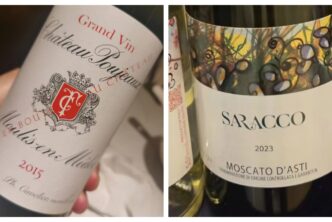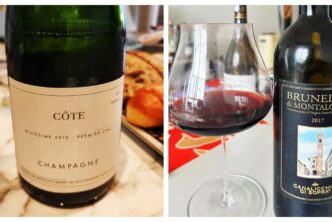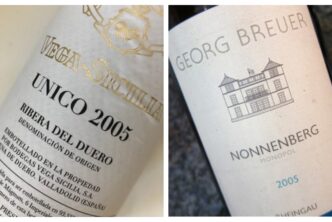Bodegas La Cana 2018 La Cana Navia 92

One of the great aspects of living in New York is that I have the opportunity to taste so many wines with the importer/distributors who bring them here. Repeated tastings not only strengthen palate acuity but opens the taster to hundreds of wines which she or he might never taste otherwise. It is the nature of every tasting to allow the taster to uncover the few wines of sufficient distinction, individuality and quality as to make them worthy of being brought to the attention of readers. You might say that this is the real responsibility of every wine reviewer: find the wines worthy of seeking out, then write about them in such a way to make it clear why the reviewer found them so interesting, and score them responsibly. Having recently tasted over fifty Spanish wines imported by Jorge Ordonez (whose role in bringing top Spanish wines to the attention of wine lovers and the market can hardly be exaggerated), I found three which grabbed my palate and my imagination. In this report I want to focus on an excellent Albariño, currently Spain’s most sought-after white wine.
Many wines drinkers assume that Albariño has been playing a major role in Spanish white wines for a very long time. The truth is that prior to Jorge Ordonez’s work with several wineries in the Rias Bixas AOC, there was very little Albarino in Spain. Even now, 30 years after Ordonez’s breakthrough work there are only 13,000 hectares planted to Albariño. It is a fascinating varietal with small berries and thick skins. In the best versions of its wines, there is a welcome touch of bitterness and chewiness which can only come from the skins fermenting with the juice. Scents and flavors of grapefruit, melon, apricot and peach abound. The salinity in the finish of a good Albariño shifts the perspective of the taster. In the last analysis it is the non-fruity characteristics which define a good Albariño.
The wine I tasted, over and over I might add, comes from the Bodegas La Cana located in the Val do Salnes. The region skirts the coast and produces wines with intense minerality and salinity. The terroir is crumbled limestone (calcaire) with a mixture of sand. The intense solar activity is moderated by the sea breezes from the nearby Atlantic Ocean. The grapes undergo a cold soak before being fermented in a mixture of older mid-sized oak barrels (35%) and tank (65%). Regular batonnage (lees stirring) is essential to the wines, as the phenolics from the skins and the high acidity inherent to the grape help prevent oxidation. The grapes for the La Cana Navia were planted in 1962 and are going strong. This is the most serious Albariño I have tasted to date. I was immediately struck by the density, the materiality, of the wine. The impact of the tannins and flavors of the skin play a central role in the wine. Like many serious wines it demands attention and respect. This is not an uber-friendly, refreshing style of Albarino. The terroir and fruits flavors are all in the service of the wine’s substantiality. I was impressed. This is a wine for serious seafood and hard ripened cheeses. Moderate in price, the Cana Navia is a first-rate value in serious white wine; my advice is to enjoy it now through 2026.
Domaine du Cayron 2018 Gigondas 93+

For me and many of my friends, one of the most distressing change in wine has been the ever-increasing alcohol levels in Châteauneuf-du-Papes—as the prices move up in lockstep with the heat! If there is one wine producing region that does not need global warming it is the southern Rhone. I find the 16-degree red wines all but undrinkable. Terroir nuance and aromatic precision are simply overwhelmed by so much alcohol. Even in Bordeaux, the heat is palpable compare with 20-30 years ago. If it is one wine that can handle the heat with aplomb it is Amarone. The dry aging of the grapes also increases acid concentration relative to sugar levels. Great north Italian reds possess one sensory attribute which is not matched in France or anywhere else so far as I know and that is bitterness. Ripeness balanced by acidity and a hint of bitterness makes for a compelling vinous experience. However, I did not write this piece to praise Amarone or excoriate Châteauneuf-du-Pape. I simply wanted to put my great affection for a southern red Rhone is context: A superb wine from the Gigondas appellation located to the north and east of Châteauneuf-du-Pape at a much higher elevation. Sheltered by the strikingly jagged Dentelles de Montmirail and built on a bed of limestone, the best vineyards of Gigondas tend to produce “more aromatic and slightly gentler” wines that Châteauneuf-du-Pape. I have quoted from what is still one of the indispensable wine books: The 7th edition of The World Atlas of Wines (I love British under-statement. Slightly actually means much). The Gigondas I am writing about is from an excellent estate called Domaine du Cayron. This fourth-generation estate is now run by three sisters: Delphine, Roseline and Cendrine Farraud. Viens are very old – between forty and seventy years of age. Nearly 80% of the blend is made up by Grenache, with 14% Syrah and other locals. The fermented juice is aged for two years in foudres (large oak barrels) that are at least fifty years old. The Farraud sisters keep yields to 25-26 hectoliters/hectare – well below the allowed in Gigondas and frankly, much lower tha those found in many famous Burgundy estates and of the northern Rhone. The wines are made traditionally, with growing of the grape and aging of the wines transformed into a living, joyous artwork. The 2018 Domaine du Cayron Gigondas takes the taster on a wonderful journey from rich dark fruits to leathery, earthy notes and herbal spices elevated by strikingly fresh acidity which causes the wine to permeate the palate in waves of sensations. The finish, if that is the right word, simply continues the wine’s presence for at least a minute. Each taste invites another and there is no sensation of heat evident. The Cayron Gigondas demonstrates that it is possible to harness mother nature in the interest of expressing the soil and the growing conditions to perfection. I very much appreciated the vigour and intensity of the wine early in its life, but it will be fine for decades. I add that the price of this wine is remarkably affordable in light of its quality. It is always a thrill to discover wines which taste so much better than their cost implies. Drinking window: now-2031

 中文
中文



